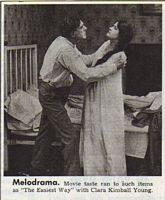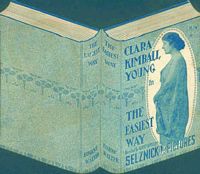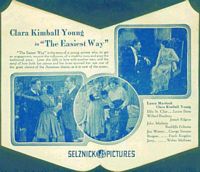

The Easiest Way (1917) Clara Kimball Young Film Corp. Distributor: Lewis J. Selznick Enterprises; Selznick Pictures. Director: Albert Capellani. Scenario: Albert Capellani and Frederic Chapin. Camera: Hal Young and Jacques Monteran. Cast: Clara Kimball Young, Louise Bates, Joseph Kilgour, Rockcliffe Fellowes, Cleo Desmond, George Stevens, Frank Kingdon, May Hopkins, Walter McEwen. 7 reels. This film is apparently LOST
| Picture from unidentified magazine, probably from the 1940s. |  |
A program from the film (thanks to Randy Bigham)
| Outside of program |  |
| Inside of program |  |
| Laura Murdock | Clara Kimball Young |
| Elfie St. Clair | Louise Bates |
| Willard Brockton | Joseph Kilgour |
| John Madison | Rockcliffe Fellowes |
| Annie | Cleo Desmond |
| Jim Weston | George Stevens |
| Burgess | Frank Kingdon |
| Nellie DeVere | Mae Hopkins |
| Jerry | Walter McEwan |
Our old friend Bill Shakespeare summed it up in the fewest possible words when he made the statement that "The play's the thing." The film adaptation of Eugene Walter's drama "The Easiest Way" directed by Albert Capellani for the Selznick Co., with Clara Kimball Young in he stellar role, is far and away the finest visualization of the workings of metropolitan night life ever offered for public approval. By this is meant that the finished product, intrinsic drama, construction, titles to carry the progression of the tale, selection of star and supporting cast, stage direction and its atmospheric detail, selection of locations, photography, etc. have all been combined into a composite of excellence that spells success. The film version begins far ahead of the legitimate drama, designed to show how Laura Murdock (Miss Young) was tempted to take up the life of ease and luxury as the mistress of Willard Brockton. The "back stage" detail it shows, devoid of all glamour; then her entry into the Bacchanalian orgies, her remaining for the night, with the difficulty of shaking it off. She arrives in Denver as the star of a traveling organization--"a third-rate actress with a first-class man behind her" --meets James Madison (Rockcliffe Fellowes), falls in love with him, and from then on the film version follows closely the Walter play to the "tag" of the piece wherein Laura says to her maid: "Doll me up Annie--I'm going over to the Montmartre and to hell," and then continues, with the idea of preaching a strong moral lesson. Laura goes to Montmarte and there sees Madison, who leaves at once and sees her enter a cab with a lecherous old man who attempts to embrace her. Laura gets out of the cab, seats herself on a park bench and pictures to herself her future as a common street walker, goes over to the dock and jumps overboard. Madison is phoned by the police, they having found a letter in her pocketbook addressed to him. The note reads: "Why did you leave me alone? What chance has a woman to fall and rise again. I love you. God bless you. Good-bye." He kneels by her cot in the hospital and she dies. When a photoplay can hold you for 7,4000 feet after you are already familiar with the story, it is the best test of worth. Miss Young has never done any finer film acting than in this picture. She is ideal for the star part.
"The Easiest Way"
Seven Reel Screen Version of Eugene Walter's Realistic Drama Presents Clara Kimball Young as the Unhappy Heroine--Selznick Pictures Release.
Reviewed by Edward Weitzel.
The uncompromising truth was the watchword of Eugene Waiter when he wrote "the Easiest Way." A seven-reel screen version of this vital drama has been produced by the Selznick company with Clara Kimball Young in the role created by Frances Starr. If there are any moving picture exhibitors not familiar with the story, it may be stated that the heroine is an actress, an attractive young woman, who finds the struggle for existence too hard for her, and accepts the protection of a wealthy broker. Later she meets a penniless young reporter, and they both fall in love. Both are honest about their past lives, and agree to overlook whatever has happened. The girl ends her affair with her protector and looks forward to the day when she and the reporter shall be married. While waiting for her lover to make a fortune in the West, she becomes disheartened by her struggle to secure an engagement, and goes back to her former companion. She makes him break his word to his rival, and the play ends with both men leaving her. The last seen of her in this version shown at the Rialto theater, New York, she has found another elderly protector. Another ending has been prepared. In this one she attempts suicide, is rescued, taken to a hospital and dies in the reporter's arms.
One thing could make such a story acceptable to people of intelligence and the right moral outlook--its truth. As a page from life, the life of temptation and bitter disillusion that many women are forced to lead by the struggle for a livelihood. "The Easiest Way" effects no compromise with fact. Weakness of character alone wrecks the happiness of Laura Murdoch. She does not do wrong for the love of the wrong, but from lack of will power to vanquish it. Such a woman is never outside the pale of human compassion.
The picture version adheres closely to the stage drama. A regrettable number of the skillful touches by which the author made clear the acts of his characters have been left out, but enough of the original material remains to hold the interest at all times, and to point the moral. Albert Capellani's direction is excellent throughout, and Clara Kimball Young succeeds admirably in indicating the moods of Laura Murdock. Joseph Kilgour is seen in his original character of the broker--a flawless piece of work, Rockcliffe Fellows as John Madison, Louise Bates as Elfie St. Clair, Frank Kingdon as Burgess and Walter McElweas as Jerry contribute superior quality impersonations.
[Photo omitted--not legible]
SELZNICK PICTURES
THE EASIEST WAY. (Seven Parts--April). The cast: Laura Murdock (Clara Kimball Young); Elfie St. Clair (Louise Bates); Willard Brockton (Joseph Kilgour); John Madison (Rockcliffe Fellowes); Annie (Cleo Desmond); Jim Weston (George Stevens); Burgess (Frank Kingdon) Nellie De Vere (Mae Hopkins); Jerry (Walter McEwan) Directed by Albert Capellani.
Laura Murdock is a young actress. Her husband, a drunkard, is killed by a fall, Laura goes to New York to get an engagement and finds herself blocked at every turn by the petty jealousies and politics of the profession. Willard Brockton, a wealthy banker, has been asked a production and has refused. He meets Laura and becomes interested, furnishes the producer with money demanding in return that Laura be given the best role in the piece.
Eventually Brockton claims the customary reward of such assistance, although Laura holds out as long as possible. The following summer she goes to Denver for a stock engagement, and falls in love with John Madison, a newspaper writer. He cannot afford to marry and Brockton, who comes West to take Laura back with him, sneers at the idea of his marrying the luxury-loving Laura. Laura promises to wait, however, and Brockton promises Madison that if Laura returns to him he will let Madison know.
Laura returns to New York, and Brockton's influence prevents her from getting an engagement. She reaches the end of her resources and, not hearing from Madison submits to what she regards the only course open, a renewal of her relationship with Brockton. Brockton dictates a letter to Madison which Laura promises to mail, but she burns it instead.
Madison finds gold and hurries to New York to marry Laura. He discovers the facts of the situation, and Laura confesses that she burned the letter Brockton had promised to send. Deserted by both men she becomes desperate, and tries to fling herself into the dissipations of the night life of Broadway. "She is disgusted, however, and attempts to end her life in the river. She is rescued and taken to a hospital. Madison is notified, and learns also of the fight she made to remain true to him. He hurries to her side just in time to let her know he understands and forgives, and she dies in his arms.
"The Easiest Way"--Selznick.--Another link in the Clara Kimball Young cycle of erring women. Adapted from the famous stage-play of Eugene Walter, the photodrama loses little of its force, altho some of the crucial situations lack the sledge-hammer blows of Walter's lines. Miss Young cannot be excelled in the portrayal of "experienced love," and her support was excellent
E.M.L.
EUGENE WALTER'S play, "The Easiest Way." has reached the screen at last, and with Clara Kimball Young in the principal role it proves to be a quite satisfactory picture. Miss Young gives a far better performance in this piece than she did in "The Price She Paid," which was a woefully defective and uninteresting play. "The Easiest Way," as a photoplay, is enriched by the numeous details whichwere impossible in a stage production, and the story is brought to a more logical conclusion than it was in its original form.
Last revised October 13, 2005